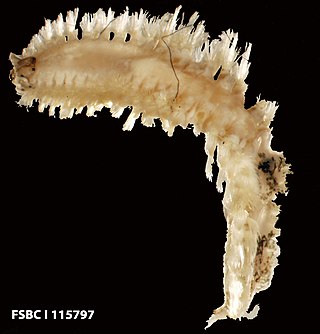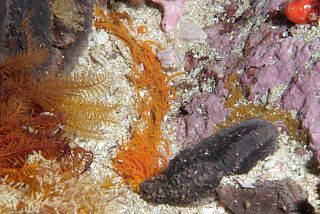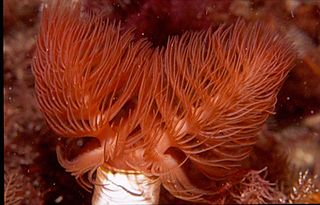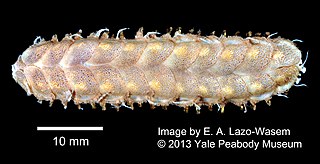
The genus Glycera is a group of polychaetes commonly known as bloodworms. They are typically found on the bottom of shallow marine waters, and some species can grow up to 35 cm (14 in) in length.

Nereis is a genus of polychaete worms in the family Nereididae. It comprises many species, most of which are marine. Nereis possess setae and parapodia for locomotion and gas exchange. They may have two types of setae, which are found on the parapodia. Acicular setae provide support. Locomotor setae are for crawling, and are the bristles that are visible on the exterior of the Polychaeta. They are cylindrical in shape, found not only in sandy areas, and they are adapted to burrow. They often cling to seagrass (posidonia) or other grass on rocks and sometimes gather in large groups.

Nephtys is a genus of marine catworms. Some species are halotolerant to a degree in that they can survive in estuaries and estuarine lagoons down to a salinity of 20 psu.

Harmothoe is a genus of marine Polychaete worms belonging to the family Polynoidae. Species of Harmothoe are found world-wide to depths of at least 5,000 m but are more common in shallower water.

Phyllodoce is a genus of polychaete worms, which contains about 200 species. The prostomium bears eyes, two pairs of antennae and a pair of large retractile nuchal organs. The eversible proboscis is clearly divided into two parts.

Amphinomidae, also known as the fireworms, bristle worms or sea mice, are a family of marine polychaetes, many species of which bear chaetae mineralized with carbonate. The best-known amphinomids are the fireworms, which can cause great pain if their toxin-coated chaetae are touched or trodden on. Their relationship to other polychaete groups is somewhat poorly resolved.

Cirriformia is a genus of marine polychaete worms in the family Cirratulidae.

Protula is a genus of marine polychaete worms in the family Serpulidae.

Chloeia is a genus of marine polychaete worms.

Ceratonereis is a genus of polychaete worms from the family Nereididae.

Eulalia is a genus of polychaete worms.

Lepidonotus is a genus of marine annelids in the family Polynoidae. The genus occurs globally and includes 80 species, usually found in shallow waters down to about 80 metres.
Aglaophamus is a genus of free-burrowing nephtyid worms.
Amphitrite is a genus of polychaetes belonging to the family Terebellidae. The genus has cosmopolitan distribution.
Marphysa is a genus of annelids belonging to the family Eunicidae.

Hermodice is a genus of annelids belonging to the family Amphinomidae.
Sigalionidae is a family of polychaetes belonging to the order Phyllodocida.
Vermiliopsis is a genus of polychaetes belonging to the family Serpulidae.
Lumbrineris is a genus of polychaetes belonging to the family Lumbrineridae.













